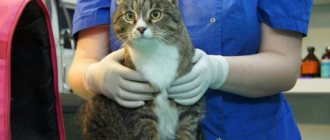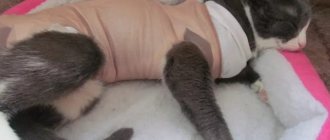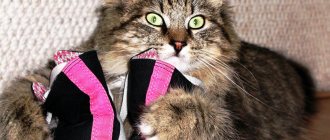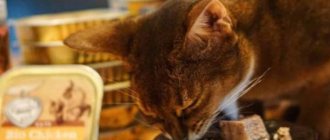Cats, just like people, have a fairly high risk of injury every day. Nevertheless, these animals sometimes become injured, and the wounds begin to fester. In this article you can learn how to avoid wounds from festering , as well as how to treat purulent wounds in cats . In order not to get confused or panic, we recommend collecting as much information as possible on this disease.
Causes
An abscess occurs due to the introduction of bacterial microflora into the wound. When the skin is restored, pus accumulates under it, and there is no outflow. This problem occurs in cats and kittens, but most often in cats, which quite often start fights among themselves. The most common cause of a purulent abscess is infection of wounds resulting from fights with other animals. Since cats have a lot of microbes on their nails, the wound received from them becomes infected immediately.
Other causes of subcutaneous suppuration:
- Damage to the mucous membranes in the animal's mouth by fish bones. Particularly dangerous are old rotten remains, which harbor a large number of pathogenic microorganisms;
- Damage to the skin of a cat by a bird or other animal;
- Injection with an infected syringe;
- Subcutaneous administration of a drug that is poorly absorbed;
- Damage to the mucous membranes from a chipped tooth or suppuration of the tooth root;
- Injury to the paws from a thorn or thorn.
Abscesses in cats can occur several times throughout their lives, so the owner needs to be able to distinguish between this problem. In the early stages, the disease responds well to treatment, which means it is important to contact a veterinarian in a timely manner without waiting for your pet’s condition to worsen.
Necessary diagnostic measures
The manifestation of parallel symptoms indicates the need to show the animal to a specialist.
When a cat scratches its neck until it bleeds and other unpleasant symptoms are observed, you should contact a veterinary clinic. The specialist will examine the pet’s damaged skin and assess the animal’s general condition. Simple disorders such as allergies can be determined by visual inspection and determination of the cat’s diet or its possible contact with irritants. If it was not possible to determine the causes of wounds on the neck in this way, then additional diagnostics are carried out, which include the following manipulations:
- laboratory blood test;
- general analysis and bacterial culture of urine;
- allergic reaction test;
- scraping to identify pathogenic microorganisms.
Types of disease
Most often, abscesses occur on the skin of the animal, as well as mucous membranes. Depending on the location of the source of suppuration, abscesses are divided into several types:
- Superficial - located under the epidermis layer, are small in size and very rarely cause sepsis;
- Deep - develop in the muscle area and subcutaneous fatty tissue; as a rule, they can only be detected by touch;
- Odontogenic - occurs due to problems with teeth;
- Paraanal - arise due to the presence of an inflammatory process in the paraanal glands of the animal;
- Suppuration on the head, paws, neck, and back of the body.
Abscesses in the cheek or eye area are very rare.
Diagnosis of purulent formations
An external examination will easily reveal the presence of an abscess. For a doctor this will not be difficult. It happens that it is necessary to do a bacteriological examination of material from the source of infection. In the initial stage, several examinations may be required to determine the correct diagnosis.
First, the veterinarian palpates the suspected foci of inflammation, and then trims the hair in and around the festered area. It is important to find all the affected areas in order to treat them too.
Symptoms
An attentive owner will notice an abscess in a cat on his own. A change in the pet's character and an alarming reaction to touch in certain places may indicate the presence of this problem. Most often, the abscess can be found on the tail, paws, neck and head. It is these parts of the body that cats scratch the enemy during a fight.
A mature abscess can be seen with the naked eye: swelling and redness appear. If the wound is open, blood and pus begin to come out of it, and an unpleasant odor appears. The cat experiences a rise in temperature, lethargy, and his appetite worsens or completely disappears.
If the animal has good immunity, then the abscess can burst, pus will flow out of it, and the wound will heal. But it often happens that the outflow does not form, and the abscess itself causes severe suffering to the animal. At the same time, it becomes very aggressive, completely refusing to eat and communicate with its owners.
The course of an abscess in cats:
- Infection in the wound;
- The appearance of redness and swelling;
- The occurrence of a local increase in temperature in the area where there was previously a wound;
- The area becomes painful;
- A large tumor appears, the skin becomes very red;
- Through a thin layer of skin you can see and feel a lesion with pus;
- Self-opening of an abscess or spreading of pus to surrounding tissues.
Pets that spend a lot of time outside the home, on the street, in places with large concentrations of animals are highly susceptible to this disease.
How to treat a cat's wound
Primary treatment of wounds, washing, washing abscessesAny of the products is directly poured onto the surface, sprayed or injected into the abscess cavity to wash out the inflammatory-purulent exudate. The products are quite cheap and can be used in large quantities. | |
| Hydrogen peroxide 3% (7-10 RUR/100 ml) | Chlorhexidine (about 20 rub./100 ml) |
| Furacilin (about 100 rub./10 tablets) | Fukortsin (from 40 rub./25 ml) |
Absolutely all powders/powders have excellent antiseptic, wound healing and absorption effectsIt is good to use them in deep, wet wounds where there is a cavity pocket. Wounds often fall asleep and are stitched up. The wound cavity is filled abundantly and tightly with any of these agents and an outflow of the resulting exudate is formed. The procedure is carried out 1-2 times a day until completely dry or according to the instructions for each drug. Then they usually switch to ointments. | |
| Iodoform powder (RUB 75-105/10 g) or Edis powder powder (RUB 150/200 g) | Xeroform (about 100 rub./10 g) |
| Powder Gentaxan (170-210 rub./2 g) | Baneocin powder (up to 400 rub./10 g) |
Wound healing, antimicrobial and analgesic ointments/creams are used on dried wounds or shallow weeping wounds.They perfectly stimulate granulation (the formation of connective tissue - the tissue that forms scars). Some contain an anesthetic component (Levosin, Fastin, Ranosan). May cause drooling due to licking by animals, because bitter. All preparations are applied in a thin layer, lightly rubbing in. It is better to blot the excess with a napkin, because... they melt due to body temperature, spreading greatly beyond the wound. | |
| Levomekol (about 120 rub./40 g) | Levosin (80-100 rub./40 g) |
| Fastin (50-85 RUR/25 g) | Ranosan (about 70 rub./10 g) |
Rivanol(from 100 rub./200 ml) 0.05%, 0.1% and 0.2% solutions are used for washing wounds, as well as in the form of powder or ointment. Do not use on extensive injuries if the cat has problems with the kidneys. |
Iodine solution(17-25 RUR/25 ml) It is used extremely rarely in cats. These are mainly targeted applications (for example, cauterization of areas after removing ticks). It is better to treat open wounds only strictly around the edges. May cause burning and additional local irritation. |
Brilliant green solution (brilliant green)(40-74 RUR/15 ml) The most universal remedy for treating wounds, abrasions, postoperative sutures, etc. Has a pronounced antiseptic and drying effect. Do not use for deep injuries (do not pour inside the wound). |
Aluminumspray(about 300 rub./100 ml) Suitable for treating any wounds in cats, but always after preliminary cleansing. It is especially good to use on postoperative sutures. It has not only an antiseptic effect, but also an enveloping and protective effect. Spray at a distance of 15-20 cm above the wound for 1-2 seconds. Usually once a day for 7-10 days is enough. It has no contraindications or side effects. |
Chemi spray(380-500 RUR/200 ml) A product with antimicrobial and anti-inflammatory properties. Has a detrimental effect on fungi of the genus Candida. Non-irritating, but with a very strong odor - best used outdoors. It is important to clean the wound before spraying: remove pus, crusts, dirt, necrotic areas, etc. Apply up to 3 times a day, the duration of use usually does not exceed 10 days. |
Vetericin(RUB 1100-1300/118 ml) A very powerful all-purpose antimicrobial-healing agent for any kind of cat wound you might have. Apply 3-4 times a day - or simply spray on the surface or under the bandage (apply a moistened wet gauze cloth, a bag and a bandage on top). There are no restrictions on days of use - until healing. It has one significant drawback - cost, therefore it is most often used in veterinary clinics, and not for private use. |
Syntomycin ointment(from 100 rub./25 g) One of the best ointments for healing weeping wounds accompanied by purulent discharge, as well as burns. It is most effective to apply under a bandage. |
Possible complications
The danger of an abscess is that this disease can cause severe complications that significantly worsen the pet’s condition and can also be fatal.
Complications of an abscess:
- Overgrowth of affected areas, formation of purulent phlegmon;
- Tissue necrosis;
- Blood poisoning;
- Sepsis;
- Death.
Often, through the wound that led to the formation of an abscess, the pathogens of rabies, feline leukemia or immunodeficiency virus penetrate and spread throughout the body.
In order to avoid serious consequences for the animal’s body, it is necessary to contact a veterinarian as soon as possible after discovering an abscess in a cat.
Symptoms
The most common place for an abscess to form is skin damage caused by other cats in a fight. Most often these are the tail, limbs, head and ears. It is not difficult to visually identify an abscess if you pick up the cat and try to examine it. True, when trying to feel the painful area, she begins to actively resist, which also indicates subcutaneous inflammation, even if it has not yet manifested itself too much. When purulent infiltrates form on the limbs, the pet will begin to walk with a limp.
If the abscess has already matured, then there will be a pronounced tumor under the skin. The animal loses its appetite, the temperature may rise, chills, and lethargy appear - all the signs of an infectious disease are evident. The wound is opened, pus with blood flows out of it and there is a fetid smell of rot. Scabs begin to form.
Treatment
It is better to entrust the procedure for eliminating an abscess in a cat to a veterinarian, since it is difficult for an inexperienced person to perform all the necessary manipulations.
The disease will be treated in a clinical setting in several stages:
- Opening the abscess and washing out the fluid from it;
- Application of disinfectants;
- In advanced cases, the wound expands and dead tissue and muscles are removed;
- A drainage is installed inside the wound to drain the pus, which is removed after 3-5 days;
- The cat is put on a special cone-shaped collar, which will prevent the animal from scratching the wound;
- A number of painkillers and antibiotics are prescribed.
As a rule, the abscess completely disappears within a week after the pus is removed from the wound.
If it is not possible to contact a veterinarian, then treatment is carried out at home, which involves opening the abscess and removing the pus with sterile wipes. After this, you should wash the wound with a disinfectant: furatsilin or peroxide, and apply a bandage using Vishnevsky ointment. Next, the wound needs daily washing and dressing until the pus disappears. If there is no improvement within two weeks, then it is advisable to show the animal to a veterinarian.
List of acceptable medications for treating wounds in cats
Attention, not all drugs approved for use on dogs are approved for cats! Unauthorized drugs include:
- preparations containing lidocaine, tar (for example, Yam ointment) and benzyl benzoate (often incorrectly used to heal scabies wounds);
- iodine;
- Vishnevsky ointment.
All of these drugs are more or less toxic to cats and can cause poisoning due to extensive absorption into the blood through the skin. In addition, a chemical burn of the skin (iodine) can be caused and the area of the wound surface will increase.
Prevention
The main preventive measure that will protect against the appearance of a purulent abscess in a pet is to limit movement on the street and contact with other animals. If it is not possible to control the cat on walks, you should reduce its aggressiveness by castration or sterilization.
It is necessary to ensure that the animal does not eat from a trash can or garbage can, where the remains of small fish bones can be found. You should carefully examine your pet’s body for wounds or abrasions, and if there are any, treat them until they are completely healed.
To prevent abscess of the paraanal glands in a cat, they should be systematically cleaned of the accumulation of secretions. It is best to entrust cleaning to a specialist, since an untrained person can cause pain to the pet and cause an aggressive reaction.
How to care for a cat during recovery
To speed up the healing process, it is not recommended to let your pet outside. It is necessary to provide him with rest and proper nutrition. The diet should be balanced and aimed at eliminating infection in the cat’s body.
In addition to regular food, you can add vitamins prescribed by the veterinarian
It is not advisable to include in food:
- smoked products;
- sausages;
- sweet.
Particular attention should be paid to dairy products, lean meats, fish and vegetables.
Pets sometimes find themselves in unpleasant situations that result in injury. So that the injury does not come as a surprise to the owner, the person must know how to provide assistance for various injuries. It should be remembered that the health and future life of the pet depends on the actions of the owner.
Anal gland infection
This gland secretes a secret that cats use to mark territory, attract females and scare enemies. It is located in the anus and in a healthy animal is cleared during the act of defecation.
In some cat breeds, the gland canal becomes blocked for various reasons. If it is not cleaned in time, pathogenic bacteria will cause an abscess, and after it opens, a fistula will form. This is extremely dangerous and the pet may die. In this case, treatment should only be carried out by a specialist. For some breeds, the veterinarian recommends cleaning the anal glands as a preventative measure.











